|
Objective overview客观的概述
1. Perform genetic transformation through the method of bacterial transformation通过细菌转换的方法进行遗传转化
2. Observe the results of bacterial transformation in various growth condition and determine the degree of success of your efforts to genetically alter an organism.观察细菌转换的结果在不同的生长条件和确定你的努力的程度的成功基因改变有机体
Before coming to the lab
1. Read section 12.6, 13.1, 14.2, 18.2 and 18.4 table in “Life – The Science of Biology”, 9th edition”; Sadava, Hillis, Heller, Berenbaum,
2. Describe the flow of genetic material
3. Understand the transformation protocol
Introduction
A gene is a fragment of DNA which provides the instructions for making a protein. This protein gives an organism a particular trait or phenotype. Genetic transformation literally means change caused by genes, and involves the insertion of a gene into an organism in order to change the organism's trait. In this lab you will perform genetic transformation to E. coli. This is a very rare event, in which only about 1 in a million (106) cells take up the DNA. Genetic transformation is used in many areas of biotechnology. In agriculture, genes coding for traits such as resistance to frost, pest, or spoilage can be genetically transformed into plants. In bioremediation, bacteria can be transformed with genes enabling them to digest oil spills. In medicine, diseases caused by defective genes are beginning to be treated by gene therapy; that is, by genetically transforming a sick person's cells with functioning copies of the defective gene that causes the disease.
You will use a procedure to transform bacteria with a gene that codes for Green Fluorescent Protein (GFP). The real-life source of this gene is the jellyfish Aequorea victoria. Green Fluorescent Protein causes the jellyfish to fluoresce around the rim of the organism (for unknown reasons). Following the transformation procedure, the bacteria express their newly acquired jellyfish gene and produce the fluorescent protein, which causes them to glow a brilliant green color when the GFP is excited by ultraviolet light.
In this activity, you will learn about the process of moving genes from one organism to another with the aid of a plasmid. The method you are using today to transfer the plasmid to the bacteria is called bacterial transformation. It is the process in which bacteria take up free DNA in the environment. In this lab, you will be forcing Escherichia coli cells to take up DNA, but this process occurs spontaneously in nature, with some bacteria, leading to bacteria acquiring new traits, such as antibiotic resistance. This process, called horizontal gene transfer, is the bacterial version of the recombination of genes that normally occurs during sex in higher organisms. Because of this horizontal gene transfer in bacteria, it is more difficult to determine the species of a bacterial cell, as well as determine the evolutionary relatedness of bacteria. This lab has important links between the two modules of this course: “Is there life out there?” and “Why Have Sex?”. You will be considering these links in the second week of this lab.
Bacteria often conduct transformation using small circular pieces of DNA call plasmids that are separate from their much larger chromosomes. Plasmid DNA usually contains genes for one or more traits that may be beneficial to bacterial survival. In nature, bacteria can transfer plasmids back and forth allowing them to share these beneficial genes. This natural mechanism allows bacteria to adapt to new environments. A notable example of this adaptation is the occurrence of bacterial resistance to antibiotics, which is due, in part, to the transmission of plasmids.
pGLO plasmid carries the gene encoding GFP and a gene for resistance to the antibiotic ampicillin. pGLO also incorporates a special gene regulation system, which can be used to control transcription (expression) of the fluorescent protein in transformed cells. The gene for GFP can be switched “on” (transcribed) in transformed cells by adding the sugar arabinose to the cells' nutrient medium. Arabinose binds to the activator protein, AraC, and allows the AraC activator to bind to DNA near the promoter of GFP genes. This allows the RNA polymerase to bind the promoter and start transcribing the GFP genes. When arabinose is absent, the AraC activator cannot bind to the proper location on the DNA to activate expression (transcription) of the GFP genes.
Pre-lab Questions
1. To genetically transform an entire multicellular organism, you must insert the new gene into every cell in the organism. Which organism is more easily transformed: a multicellular organism or a single-celled organism?
2. Scientists often want to know if the genetically transformed organism can pass its new traits on to its offspring and future generations. To get this information, which would be a better candidate for your investigation, an organism in which each new generation grows and reproduces quickly, or one which does this more slowly?
3. Safety is an important consideration in choosing an experimental organism. What traits or characteristics should the organism have (or not have) to be sure it will not harm you or the environment?
4. Based on the above considerations (questions 1, 2, & 3), which would be the best choice for a genetic transformation: a bacterium, earthworm, fish, or mouse? Describe your reasoning.
5. What is the question you are trying to address with this experiment?
The questions below will be discussed in your groups during the lab. Be prepared with your thoughts about these questions BEFORE coming to lab.
6. What is/are the hypothesis(es) of your experiment? For this experiment, it might be easier to break down your hypothesis to several small hypotheses.
7. What is the purpose of having an antibiotic resistance gene in the plasmid? (Remember that only about 1 in a million E. coli cells will take up the plasmid DNA.)
8. What is the antibiotic you are using today? Do any genes on your plasmid encode proteins that have any effect on this antibiotic?
9. What is the name of the additional sugar component in some of your LB plates today? What is the purpose of adding this sugar to the plates?
10. If the transformed cells were to be grown on a media without arabinose, what color would you predict the resulting bacterial colonies to be under UV light?
11. Do you have a control in this experiment? If yes, which plate, or plates serve(s) as a control group? What are they controls for?
12. Use the table below to write down your prediction of your five plates

TA initials (should be obtained before you can proceed to the experiment):
Method – Transformation protocol (modified from BioRad)
1. Label one closed micro test tube +pGLO and another -pGLO. Label both tubes with your group's name. Place them in the foam tube rack.
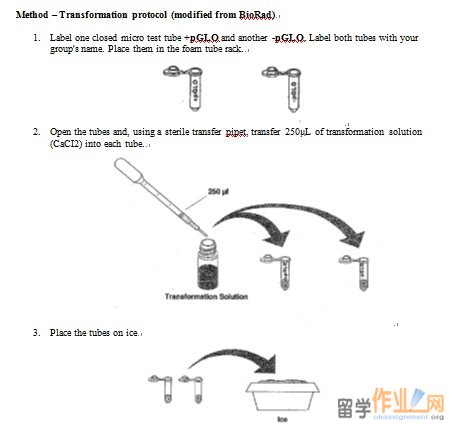
4. Use a sterile loop to pick up a single colony of bacteria from your starter plate. DO NOT PRESS INTO THE AGAR!!! Pick up the +pGLO tube and immerse the loop into the transformation solution at the bottom of the tube. Spin the loop between your index finger and your thumb until the entire colony is dispersed in the transformation solution (with no floating chunks). Place the tube back in the tube rack in the ice. Using a new sterile loop, repeat for the -pGLO tube
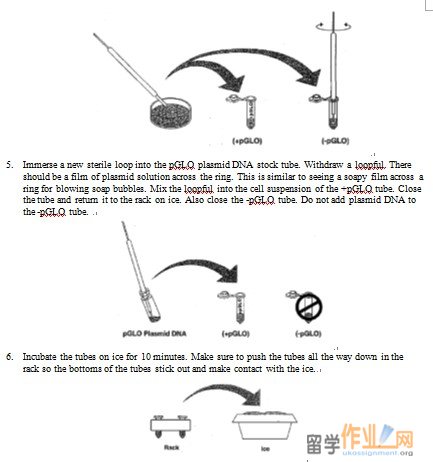
While the tubes are sitting on ice, grab the following plates from the TA table
2 LB plates (no lines)
2 LB/Ampicillin plates (1 line)
1 LB/Ampicillin/Arabinose
Label your plates on the bottom (not the lid) with your group name, today’s date, your lab day and time, your TA’s name, type of the plate, name of the organism and whether it contains the pGlo plasmid or not.
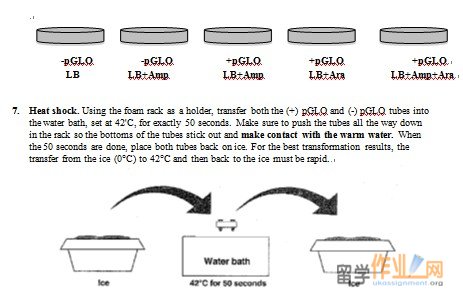
1. On which of the plates would you expect to find bacteria most like the original non-transformed E. coli colonies you initially observed? Explain your predictions. #p#分页标题#e#
2. If there are any genetically transformed bacterial cells, on which plate(s) would they most likely be located? Explain your predictions.
3. Which two plates should be compared to determine if any genetic transformation has occurred? Why?
4. What is meant by a control plate? What purpose does a control serve?
5. What did you learn today? In a short paragraph (5-6 sentences) talk about what you learned from today’s lab.
FOLLOWING WEEK – Data Analysis
Observations of your E. coli starter plate
Recall that the goal of genetic transformation is to change an organism's traits (phenotype). Before any change in the phenotype of an organism can be detected, a thorough examination of its natural (pre-transformation) phenotype must be made. The following pre-transformation observations of E. coli might provide baseline data to use when attempting to determine if any phenotypic change has occurred.
a) Describe the (1) color and (2) size and (3) distribution of colonies on the plate
b) Describe the colony appearance when viewed with ultraviolet (UV) light
Data collection
Observe the results you obtained from the transformation lab under normal room lighting. Then turn off the lights and hold the ultraviolet light over the plates. Compare colonies on these plates to the colonies on the starter plates for size and shape.
1. Use the table below. Carefully record your observations in the table below. Write down the following observations for each plate:
• How much bacterial growth do you see on each plate, relatively speaking?
more than 300 colonies:
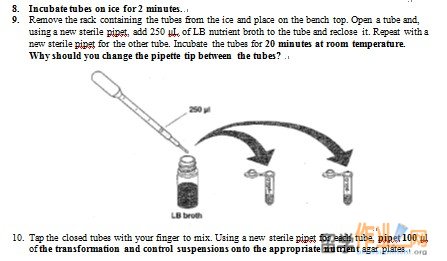
5-300 colonies:
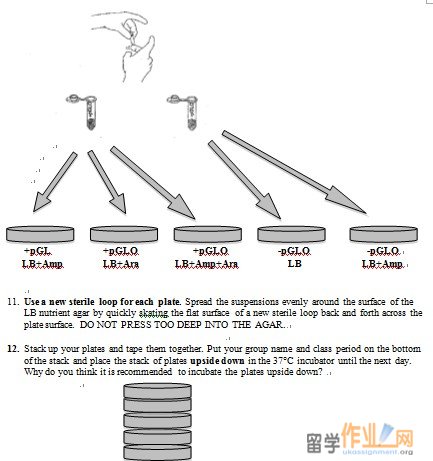
1-4 colonies: +
no colonies: -
• What color are the bacterial colonies?

Questions (2nd week):
Directions: Answer the questions below with your group AFTER you have finished collecting your data for the bacterial transformation lab. Be prepared to be called on individually during the class discussion to answer these questions.
For some strange reason, your instructors decided to put the bacterial transformation lab in the second module of the course, titled “Why Have Sex?” rather than the first module of the course, titled “Is There Life Out There?” At first glance, this might seem like an odd decision. The bacterial transformation lab clearly has direct links to the “Is There Life Out There” module because it focuses on gene expression and regulation. So…why did we put this lab in the “Why Have Sex” module? Answer the questions below to help you resolve this question.
1. Define recombination and transformation.
2. What is the PRIMARY purpose of recombination and meiosis? What is the PRIMARY purpose of transformation for bacteria?
3. How does meiosis and recombination impact the genotype of the offspring?
4. How does transformation impact the genotype of future generations of bacterial cells when compared to previous generations of parent cells?
5. Describe a primary difference between sexual and asexual reproduction in terms of the genotypes of the offspring relative to the parent?
6. Genetically, how does the end result of transformation compare and contrast to the end result of recombination and meiosis for the offspring?
7. What advantages/disadvantages are conferred to offspring of sexually reproducing organisms? Asexually reproducing organisms?
8. What advantages, if any, does transformation confer to asexually reproducing bacteria?
9. How is bacterial transformation like sex?
10. So…back to the original question. Why is the bacterial transformation lab in the “Why Have Sex” module?
Discussion (2nd week):
The goal of data analysis for this investigation is to determine if genetic transformation has occurred.
1. Which of the traits that you originally observed for E. coli did NOT appear or become altered? In the space below list these untransformed traits and how you arrived at this analysis for each trait listed.
2. Of the E. coli traits you observed on the original (starter) plates, which seem now to be significantly different after performing the transformation procedure? List those traits below and describe the changes that you observed.
New trait Observed change
3. If the genetically transformed cells have acquired the ability to live in the presence of the antibiotic ampicillin, then what might be inferred about the genes on the plasmid that you used in your transformation procedure?
4. From the results that you obtained, how could you make sure that the changes that occurred were due to the procedure that you performed?
5. If a fluorescent green color is observed in the E. coli colonies, then a new question might well be raised, "What are the possible sources of fluorescence within the colonies when exposed to UV light?" Explain.
6. Recall what you observed when you shined the UV light onto a sample of original pGLO plasmid DNA and describe your observations.
7. What does this observation indicate about the source of the fluorescence?
8. Which of the two possible sources of the fluorescence can now be eliminated?
9. Describe the evidence that indicates whether your attempt at performing a genetic transformation was successful or not successful.
10. If you add arabinose to the plate marked “–pGLO on LB”, will the colonies glow green? Why or why not?
11. Describe how you could use two LB/agar plates, some E. coli and some ampicillin disks to determine how E. coli cells are affected by ampicillin.
12. On the plate marked “+pGLO/LB+ara”, did the colonies glow green when UV light was shone on them? Why or why not?
|
 |
|||
| 网站地图 |

